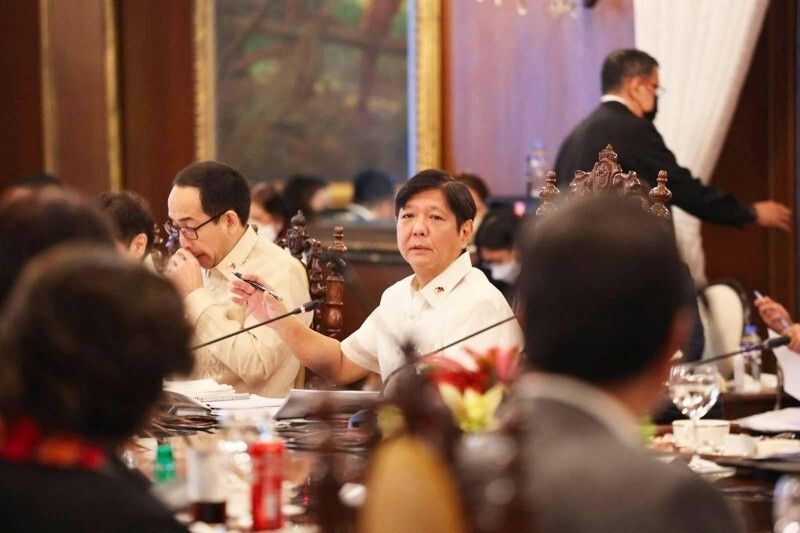Marcos' economic team sells 'ambitious' goals as Philippines faces tougher 2022

MANILA, Philippines — Inflation and prospects of external headwinds loom but economic managers of President Ferdinand Marcos Jr. are convinced that the Philippine economy will emerge strong by the end of his term.
Pronouncement came two days after Finance Secretary Benjamin Diokno bared the Marcos administration’s ambitious targets, one that preempted the Development and Budget Coordination Committee’s forecast today.
In Marcos' first year in power, growth was revised to churn 6.5-7.5%, lower compared to his predecessor’s projection of 7-8%. Economic managers explained that gross domestic product growth would slow down by the second half of the year, owing to boiling inflation and external headwinds.
Analysts say inflation hasn’t peaked yet, even with a three-year high rate recorded in June. This year, the government admitted it might miss its 2-4% inflation target amid an uptick in prices of food and fuel due in part to Russia’s continued invasion of Ukraine. Diokno was visibly irked when asked to explain why growth projections were revised down.
“That’s nitpicking,” he said.
Also dampening growth this year and next will be rate hikes by the Bangko Sentral ng Pilipinas, which Diokno said has been baked into the macroeconomic assumptions. The BSP is looking to hike 25-50 basis points in its next meeting in August, one that could as come to the aid of a weakening peso that piled onto inflation in past months.
For the rest of Marcos’ term, growth is expected to average an ambitious 6-8%, relying on a mix of more economic activity and infrastructure investments.
Fiscal plan
Revenues are expected to slowly recover but to recoup possible losses, the Marcos administration is eyeing new taxes and streamlining tax administration. Some of those have been proposed by the preceding administration, which include taxes on digital services and single-use plastic.
“You should pay a tax if it’s online,” said Diokno.
The new finance chief reiterated that Packages 3 and 4 of the Duterte-era tax reform, which include rationalizing tax rates and widening the base of real property taxes, would be passed by yearend and implemented in 2023.
The Marcos administration has yet to unveil a clear plan for growth, one that would possibly be bared in the president’s first state of the nation address by month’s end.
Nonetheless, economic managers were bullish that government revenues will come from economic growth boosted by the economy’s reopening earlier this year. Tax efforts are expected to improve between 0.3-0.4% every year, according to Diokno.
“The elasticity of tax is more than one. The faster the economic growth, the faster the revenue growth,” he said.
But Diwa Gunuigundo, former BSP deputy governor, believes that too much reliance on tax administration to improve revenues might not be enough to fix the state’s pandemic-battered balance sheet.
“Because economy is still growing, there is reluctance of both president and finance secretary to consider imposing new taxes…Tax administration have their limits. I hope we consider new taxes rather than regressive,” Guinigundo said in a forum organized by the Foundation for Economic Freedom also on Friday. “It’s important that we have fiscal space. Where does growth come from? You need more money. Do we impose more taxes or borrow more?”
Likewise, the Marcos administration wants to slash the debt-to-GDP ratio below 60% starting 2025, or back to levels deemed manageable by credit ratings agencies. A limited fiscal space and slower expectations of revenue means that the Marcos administration is motivated to turn to borrowing, showing a larger reliance on domestic funding sources.
For Diokno, there is no need to immediately return to pre-pandemic levels of debt. “Wrong to shoot for pre-pandemic debt level. It’s not crucial to return to 39%,” he said.
2022 macroeconomic assumptions
| Indicator | May DBCC meeting | July DBCC meeting |
|---|---|---|
| GDP growth/ (contraction) (%) | 7-8 | 6.5-7.5 |
| Inflation (%) | 3.7-4.7 | 4.5-5.5 |
| Dubai crude ($/barrel) | 90-110 | 90-110 |
| Peso-dollar exchange rate | 51-53 | 51-53 |
| Goods export growth (%) | 7 | 7 |
| Goods import growth (%) | 15 | 18 |
2023 to 2028 assumptions
| Indicator | 2023 | 2024 to 2028 |
|---|---|---|
| GDP growth (%) | 6.5-8 | 6.5-8 |
| Inflation (%) | 2.5-4.5 | 2-4 |
| Dubai crude ($/barrel) | 80-100 | 70-90 |
| Peso-dollar exchange rate | 51-55 | 51-55 |
| Goods export growth (%) | 6 | 6 |
| Goods import growth (%) | 6 | 8 |
Budget program
| Indicator | 2022 | 2023 | 2024 | 2025 | 2026 | 2027 | 2028 |
|---|---|---|---|---|---|---|---|
| Revenues (in trillion pesos) | 3.30 | 3.63 | 4.06 | 4.58 | 5.16 | 5.82 | 6.59 |
| Expenditures (in trillion pesos) | 4.94 | 5.09 | 5.40 | 5.76 | 6.25 | 6.92 | 7.71 |
| Surplus/ (Deficit) (% of GDP) | (7.6) | (6.1) | (5.1) | (4.1) | (3.5) | (3.2) | (3.0) |
- Latest
- Trending































